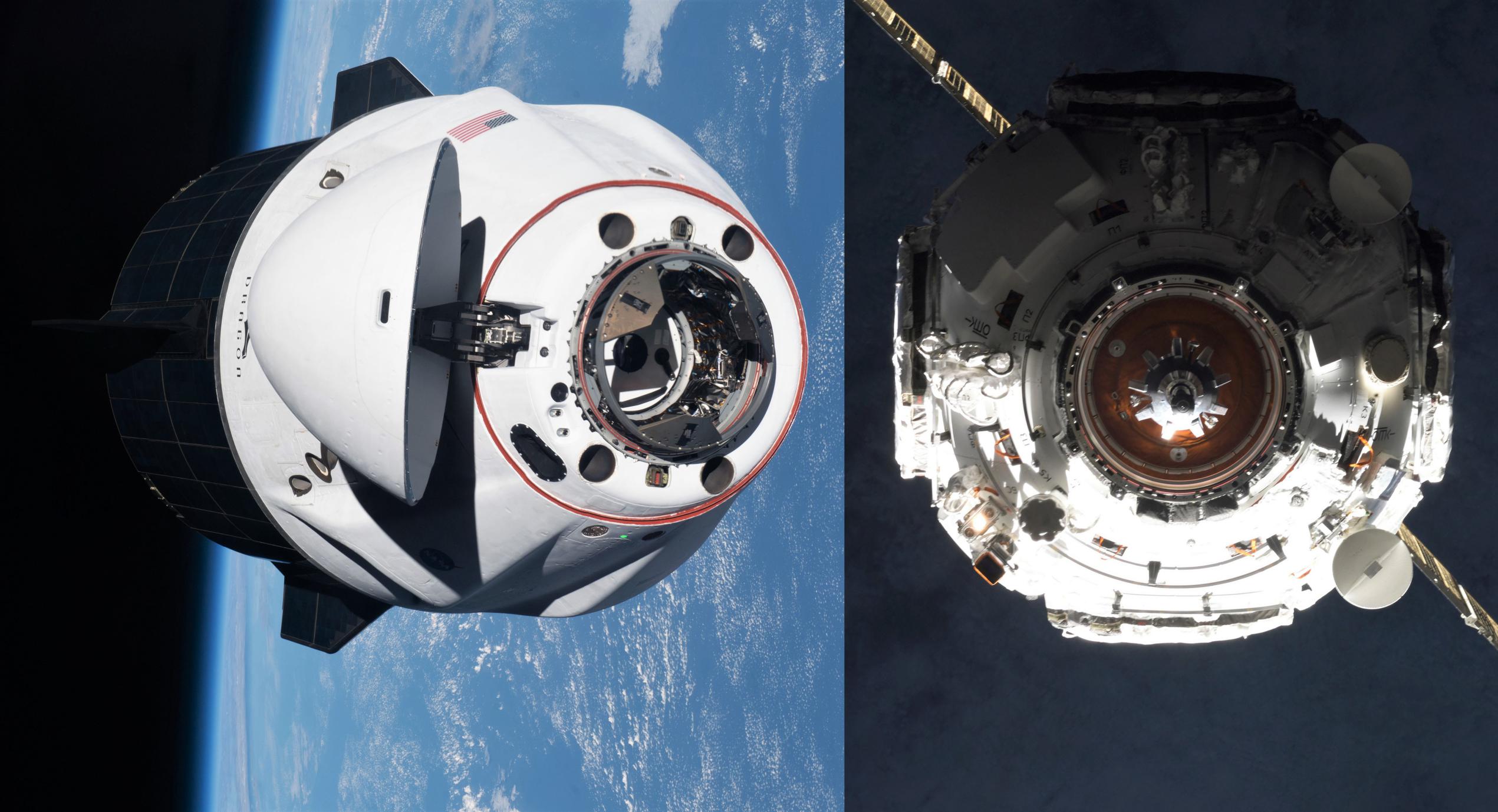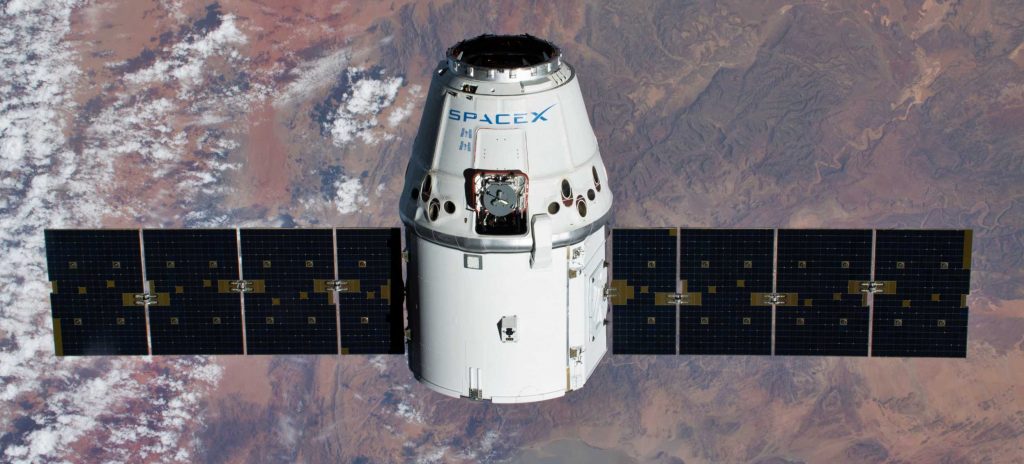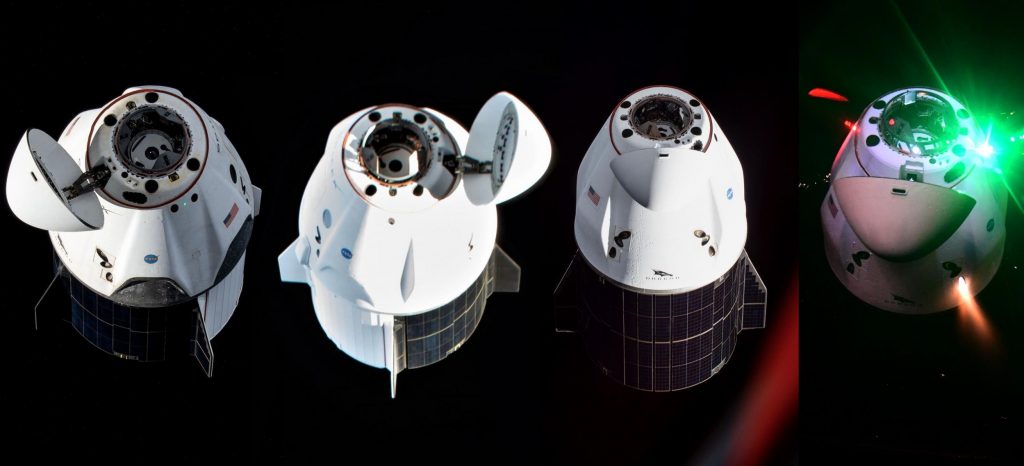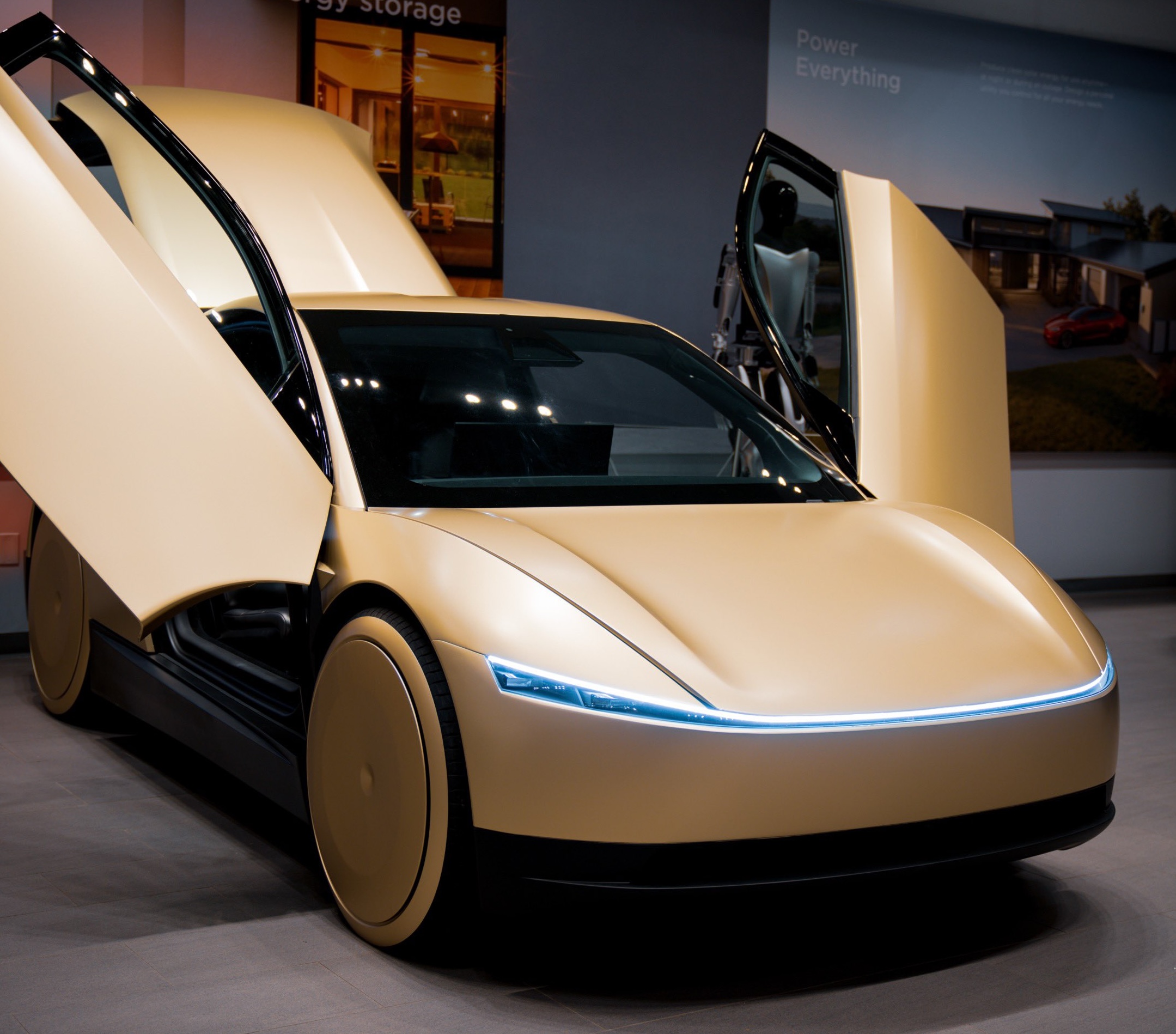

News
NASA wants SpaceX to dock Dragons at new Russian space station ‘node’
State media agency RIA says that NASA and Roscosmos are negotiating an agreement that would eventually allow SpaceX Dragon spacecraft and other future visiting vehicles to dock to a new Russian ‘node’ module recently installed on the International Space Station (ISS).
Prichal – Russian for “pier” – was successfully launched into orbit on a Soyuz 2.1 rocket on November 24th. A tug derived from the space agency’s uncrewed Progress resupply ship delivered the decade-old module to the ISS two days later, culminating in a successful docking on November 26th. Weighing almost four tons (3890kg/8600lb), Prichal is a 3.3m (~11ft) wide spherical pressure vessel whose sole purpose is to receive visiting cargo and crew vehicles and (in theory) enable further expansion of the space station’s Russian segment.
It remains to be seen if Roscosmos will be able to complete and launch any of several new planned space station modules in time for doing so to still make sense. Aside from a significant amount of uncertainty as to whether Russia will actually continue to support its ISS segment beyond 2030, Roscosmos has had a nightmarish time preparing the last two “new” segments – Prichal and Nauka. Nauka, a habitation and laboratory module, was originally planned to launch in 2007. Only fourteen years later – in July 2021 – did Roscosmos finally manage to finish and launch the module, which then proceeded to perform a long, uncommanded thruster firing that could have easily damaged or destroyed the entire station on the same day it arrived.
Meanwhile, work on Prichal began in 2007 and the module was initially expected to launch in 2013. Concerted development began in 2010 and construction was completed by 2014. Planned to be an extension of Nauka, Prichal was subsequently forced to spend almost seven years in storage before it was finally brought out of the closet and launched in November 2021.
Now, while odds are firmly against Prichal ever supporting another Russian ISS module, the ‘node’ still has plenty of potential operating solely as a docking hub or (per its namesake) a pier. Outfitted with six docking ports, one of which now connects it to Nauka and the rest of the ISS, the other five ports are effectively free to be used by any arriving Russian spacecraft – including Progress cargo ships, Soyuz crew vehicles, and next-generation Orel (Eagle) spacecraft. However, according to Roscosmos and state media outlet RIA, SpaceX’s Crew and Cargo Dragons and other US spacecraft set to use the western International Docking Adapter (IDA) standard could be added to the list of possible tenants.
To allow a spacecraft fitted with IDA to dock to one of Prichal’s four radial “ASP-GB” ports, some kind of adapter would first need to be designed, constructed, launched, and installed. The specifics of that work are likely what’s being “negotiated” – namely how Roscosmos will be compensated for building its portion of that hypothetical adapter. NASA would likely procure and provide a new IDA port, while Russia would build the ASP-GB connection. As is common for the ISS program, compensation would likely come in the form of services rendered rather than a direct payment, with NASA perhaps launching an extra Russian cosmonaut or providing a larger portion of supplies for a set period.


If realized, the addition of a third IDA port at the International Space Station would make life significantly easier for NASA. Even now, with just two spacecraft (Crew and Cargo Dragon) to worry about, NASA is forced to very carefully schedule arrivals and departures and has already had to have SpaceX perform multiple Crew Dragon port relocation maneuvers to prepare for the arrival of other Dragons. In the near future, Boeing’s Starliner spacecraft and semi-annual private Crew Dragon missions to the ISS will also enter the fray, making the scheduling and sequencing of spacecraft arrivals and departures even more challenging.
The US ISS segment really only has two ports still available for conversion to the IDA standard and both are needed to ensure safe, redundant cargo deliveries from uncrewed Cygnus and (as early as next year) Dreamchaser spacecraft throughout the 2020s. Ultimately, that means that an agreement to place a third IDA on the Russian segment is the only clear way NASA can give itself breathing room for the next decade of IDA spacecraft operations.
Elon Musk
Tesla begins expanding Robotaxi access: here’s how you can ride
You can ride in a Tesla Robotaxi by heading to its website and filling out the interest form. The company is hand-picking some of those who have done this to gain access to the fleet.

Tesla has begun expanding Robotaxi access beyond the initial small group it offered rides to in late June, as it launched the driverless platform in Austin, Texas.
The small group of people enjoying the Robotaxi ride-hailing service is now growing, as several Austin-area residents are receiving invitations to test out the platform for themselves.
The first rides took place on June 22, and despite a very small number of very manageable and expected hiccups, Tesla Robotaxi was widely successful with its launch.
Tesla Robotaxi riders tout ‘smooth’ experience in first reviews of driverless service launch
However, Tesla is expanding the availability of the ride-hailing service to those living in Austin and its surrounding areas, hoping to gather more data and provide access to those who will utilize it on a daily basis.
Many of the people Tesla initially invited, including us, are not local to the Austin area.
There are a handful of people who are, but Tesla was evidently looking for more stable data collection, as many of those early invitees headed back to where they live.
The first handful of invitations in the second round of the Robotaxi platform’s Early Access Program are heading out to Austin locals:
I just got a @robotaxi invite! Super excited to go try the service out! pic.twitter.com/n9mN35KKFU
— Ethan McKanna (@ethanmckanna) July 1, 2025
Tesla likely saw an influx of data during the first week, as many traveled far and wide to say they were among the first to test the Robotaxi platform.
Now that the first week and a half of testing is over, Tesla is expanding invites to others. Many of those who have been chosen to gain access to the Robotaxi app and the ride-hailing service state that they simply filled out the interest form on the Robotaxi page of Tesla’s website.
That’s the easiest way you will also gain access, so be sure to fill out that form if you have any interest in riding in Robotaxi.
Tesla will continue to utilize data accumulated from these rides to enable more progress, and eventually, it will lead to even more people being able to hail rides from the driverless platform.
With more success, Tesla will start to phase out some of the Safety Monitors and Supervisors it is using to ensure things run smoothly. CEO Elon Musk said Tesla could start increasing the number of Robotaxis to monitors within the next couple of months.
Elon Musk
Tesla analyst issues stern warning to investors: forget Trump-Musk feud

A Tesla analyst today said that investors should not lose sight of what is truly important in the grand scheme of being a shareholder, and that any near-term drama between CEO Elon Musk and U.S. President Donald Trump should not outshine the progress made by the company.
Gene Munster of Deepwater Management said that Tesla’s progress in autonomy is a much larger influence and a significantly bigger part of the company’s story than any disagreement between political policies.
Munster appeared on CNBC‘s “Closing Bell” yesterday to reiterate this point:
“One thing that is critical for Tesla investors to remember is that what’s going on with the business, with autonomy, the progress that they’re making, albeit early, is much bigger than any feud that is going to happen week-to-week between the President and Elon. So, I understand the reaction, but ultimately, I think that cooler heads will prevail. If they don’t, autonomy is still coming, one way or the other.”
BREAKING: GENE MUNSTER SAYS — $TSLA AUTONOMY IS “MUCH BIGGER” THAN ANY FEUD 👀
He says robotaxis are coming regardless ! pic.twitter.com/ytpPcwUTFy
— TheSonOfWalkley (@TheSonOfWalkley) July 2, 2025
This is a point that other analysts like Dan Ives of Wedbush and Cathie Wood of ARK Invest also made yesterday.
On two occasions over the past month, Musk and President Trump have gotten involved in a very public disagreement over the “Big Beautiful Bill,” which officially passed through the Senate yesterday and is making its way to the House of Representatives.
Musk is upset with the spending in the bill, while President Trump continues to reiterate that the Tesla CEO is only frustrated with the removal of an “EV mandate,” which does not exist federally, nor is it something Musk has expressed any frustration with.
In fact, Musk has pushed back against keeping federal subsidies for EVs, as long as gas and oil subsidies are also removed.
Nevertheless, Ives and Wood both said yesterday that they believe the political hardship between Musk and President Trump will pass because both realize the world is a better place with them on the same team.
Munster’s perspective is that, even though Musk’s feud with President Trump could apply near-term pressure to the stock, the company’s progress in autonomy is an indication that, in the long term, Tesla is set up to succeed.
Tesla launched its Robotaxi platform in Austin on June 22 and is expanding access to more members of the public. Austin residents are now reporting that they have been invited to join the program.
Elon Musk
Tesla surges following better-than-expected delivery report
Tesla saw some positive momentum during trading hours as it reported its deliveries for Q2.

Tesla (NASDAQ: TSLA) surged over four percent on Wednesday morning after the company reported better-than-expected deliveries. It was nearly right on consensus estimations, as Wall Street predicted the company would deliver 385,000 cars in Q2.
Tesla reported that it delivered 384,122 vehicles in Q2. Many, including those inside the Tesla community, were anticipating deliveries in the 340,000 to 360,000 range, while Wall Street seemed to get it just right.
Tesla delivers 384,000 vehicles in Q2 2025, deploys 9.6 GWh in energy storage
Despite Tesla meeting consensus estimations, there were real concerns about what the company would report for Q2.
There were reportedly brief pauses in production at Gigafactory Texas during the quarter and the ramp of the new Model Y configuration across the globe were expected to provide headwinds for the EV maker during the quarter.
At noon on the East Coast, Tesla shares were up about 4.5 percent.
It is expected that Tesla will likely equal the number of deliveries it completed in both of the past two years.
It has hovered at the 1.8 million mark since 2023, and it seems it is right on pace to match that once again. Early last year, Tesla said that annual growth would be “notably lower” than expected due to its development of a new vehicle platform, which will enable more affordable models to be offered to the public.
These cars are expected to be unveiled at some point this year, as Tesla said they were “on track” to be produced in the first half of the year. Tesla has yet to unveil these vehicle designs to the public.
Dan Ives of Wedbush said in a note to investors this morning that the company’s rebound in China in June reflects good things to come, especially given the Model Y and its ramp across the world.
He also said that Musk’s commitment to the company and return from politics played a major role in the company’s performance in Q2:
“If Musk continues to lead and remain in the driver’s seat, we believe Tesla is on a path to an accelerated growth path over the coming years with deliveries expected to ramp in the back-half of 2025 following the Model Y refresh cycle.”
Ives maintained his $500 price target and the ‘Outperform’ rating he held on the stock:
“Tesla’s future is in many ways the brightest it’s ever been in our view given autonomous, FSD, robotics, and many other technology innovations now on the horizon with 90% of the valuation being driven by autonomous and robotics over the coming years but Musk needs to focus on driving Tesla and not putting his political views first. We maintain our OUTPERFORM and $500 PT.”
Moving forward, investors will look to see some gradual growth over the next few quarters. At worst, Tesla should look to match 2023 and 2024 full-year delivery figures, which could be beaten if the automaker can offer those affordable models by the end of the year.
-

 Elon Musk2 days ago
Elon Musk2 days agoTesla investors will be shocked by Jim Cramer’s latest assessment
-

 News1 week ago
News1 week agoTesla Robotaxi’s biggest challenge seems to be this one thing
-

 Elon Musk2 weeks ago
Elon Musk2 weeks agoElon Musk slams Bloomberg’s shocking xAI cash burn claims
-

 News2 weeks ago
News2 weeks agoTexas lawmakers urge Tesla to delay Austin robotaxi launch to September
-

 Elon Musk1 week ago
Elon Musk1 week agoFirst Look at Tesla’s Robotaxi App: features, design, and more
-

 Elon Musk2 weeks ago
Elon Musk2 weeks agoTesla Robotaxis are becoming a common sight on Austin’s public roads
-

 Elon Musk2 weeks ago
Elon Musk2 weeks agoSpaceX President meets India Minister after Starlink approval
-

 Elon Musk2 weeks ago
Elon Musk2 weeks agoxAI’s Grok 3 partners with Oracle Cloud for corporate AI innovation

















